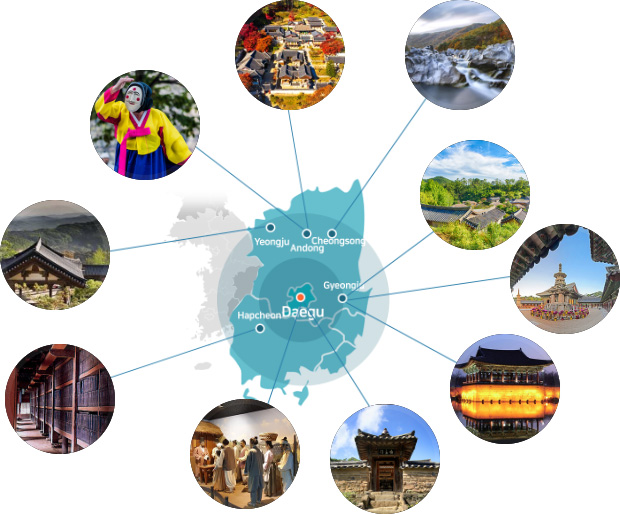About Daegu, Korea

The Hub of the National Medical Industry, Korea’s Medi-city
“Medi-City Deagu” is the flagship of Korea’s medical industry, and is home to twelve general hospitals, 3,000 medical facilities, four medical schools, and one eastern medicine school. The medical industry of Daegu was designated by the government as a key industry to foster and drive new growth. Home to Daegu-Gyeongbuk Medical Innovation Foundation research facilities, the Korean Brain Research Institute, and the Korean Institute of Oriental Medicine, Daegu is positioning itself to becoming a global hub city that offers the best in the advanced medical industry.

17 UNESCO World Heritage Sites, Just One Hour Away From Daegu
Daegu is a city of living legacy and charm embracing 3,000 years of history. Nestled within wooded mountains and the Gumhogang river flowing around it, Daegu is an ideal place to convene and relax. The congress participants are assured of a warm welcome and a comfortable stay in Daegu, a city with many historic legacies registered as the World Heritage Sites by UNESCO.
Learn moreTourism Information 観光情報
Daegu 大邱
-
Modern Culture Alley
Modern Culture Alley is the place where visitors can experience both modern times and present day of Daegu. There are many historical spots of Daegu so it is more meaningful.
Modern Culture Alley composed with five different courses and each course has its concept. Each course normally takes about 2 hours.
On the website you can apply a tour guide service for free.
-
Daegu 83 Tower
The Daegu Tower (height 202m) is located on European style theme park inside Duryu Park. It is a tourist attraction where you can look over the whole city of Daegu. The traditional architectural beauty of the tower has been reproduced and its Dabotop pagoda shape has been recreated. The west part of Daegu Tower has Duryusan, Seongdangmot and Daegu Culture and Arts Center where the tourists could enjoy various performances, exhibitions and events.

-
Seomun Market
Seomun Market is the biggest market in Daegu and the market boasts a long history and a deep-rooted tradition. Recently, Seomun Market opened a night market and now it became one of Daegu’s major public and tourist destinations.

-
Suseong Lake
Seomun Market is the biggest market in Daegu and the market boasts a long history and a deep-rooted tradition. Recently, Seomun Market opened a night market and now it became one of Daegu’s major public and tourist destinations, the market offers a wide range of merchandise and street food and serves as a venue for various public performances and art exhibitions.
Seomun Night Market opens every night from 19:30 to 24:00 (or until 24:30 on Friday and Saturday nights).
-
Palgongsan
It is the famous mountain popular with both of Daegu citizens and visitors from other areas. Palgongsan is a beautiful mountain every 4 seasons so it is good place for hiking and driving anytime.
There is famous buddha named Gatbawi and it has a nationwide reputation as a relief and faithful place where one wishes can be heard when praying to Gatbawi Buddha.
-
Gangjeong Goryeongbo Weir (The ARC)
There is a unique building at the point where the Nakdonggang river and Kumhogang rivers meet. It is also called as the Four Rivers Cultural Center and it is a different exhibition space as a building and an artwork. The ARC is designed by Hani Rashid, who has won a prestigious award for world-class architectural design. It is also a good place to ride a bicycle and it became the rising sightseeing spot because of its beautiful night view.

Gyeongju 慶州
-
Bulguksa Temple
The temple is a UNESCO World Heritage Site that is recognized as Historic and Scenic Site No. 1 by the Korean government, housing six national treasures. It was first built as a small temple in the year 528 but grew in size over time as Buddhism spread across Korea. Unfortunately, because of wars throughout history, the wooden buildings were burnt down and reconstructed in 1604.

Copyright(C) 2019 경주시 관광자원 영상이미지. All rights reserved. -
Seokguram
Designated as a UNESCO World Heritage Site since 1995, this sculpture of Buddha sitting on a lotus is built in an artificial grotto. Within the grotto, you will experience a feeling of grandeur as well as a sense of peace and tranquility from the look on the sculpture's face. It is a great representation of Buddhist art during the Silla Dynasty.

-
Cheomseongdae
The oldest astronomical observatory in the East, Cheomseongdae, is a scientific stone structure. The shape of Cheomseongdae, which is round at the top and square at the bottom, symbolizes the sky and the earth. The 365 stones that make up Cheomseongdae symbolize the number of days in a year. The 27 stone steps represent Queen Seondeok, the 27th ruler who built Cheomseongdae. The 29th and 30th steps, including the top stone, symbolize the number of days in a lunar month. The 12 steps above and the 12 steps below the middle window, through which observers are believed to have passed, represent the 12 months of the year and the 24 solar terms. This is not only an amazing scientific fact, but also evidence that Cheomseongdae was a place to observe the movement of the sky.

-
Gyeongju National Museum
Gyeongju National Museum encapsulates over 1,000 years of Silla in one place. It is a place where you can view the cultural heritages and artifacts that have been discovered and preserved. The main artifacts are the royal family’s crowns and jewelry, which you can compare to artifacts from your home country.

Copyright(C) 2019 경주시 관광자원 영상이미지. All rights reserved. -
Hwangridan-gil
Hwangridan-gil is a relatively new street in Gyeongju with over 700 shops, cafés, bakeries, restaurants, and accommodations. Though other Korean cities are known for their skyscrapers and buildings, Gyeongju, as a heritage site, has restrictions on buildings. As such, most of the buildings on this street only have one or two floors, and many of them are built in the form of a hanok (traditional Korean building), creating a warm and welcoming atmosphere for visitors.

-
Donggung Palace and Wolji Pond
Wolji, a separate palace for the princes during the Silla Dynasty, is a pond that was built in 674. Donggung, which means “palace on the east,” was created after Silla’s unification of the Three Kingdoms. It is known for its beautiful scenery, particularly during sunset and at night, when the reflections from the pond make it even more beautiful.

-
Waljeonggyo Bridge
Not far from Gyochon Village is Waljeonggyo, a wooden bridge over the river. Originally, it was recorded to have been built in 760 and lasted for over 520 years. However, historical records indicate that it was burned down during a war, and all that was left of the bridge were its stone piers. Korea decided to reconstruct the bridge in 2004, and it was reopened in 2018.

Andong 安東
-
Hahoe Village
The village is famous for being the home of the Joseon Dynasty's Confucian scholars, Sir Gyeomam Ryu Unryong and Sir Seo-ae Ryu Seongryong. The name 'Hahoe' came from the fact that the river flow of Nakdonggang surrounds the village. The village is famous for Byeolsin Gut Mask Dance and Hahoe Mask. The whole village is designated as Important Folk Material.

Copyright(C) 2002~2009 Hahoe Village Superintendent's Office. All rights reserved. -
Dosanseowon
Dasanseowon(Confucian Academy) shrines the most famous Confucian scholar in the Joseon Dynasty, Toegye Lee Hwang. Dosanseowon Confucian is primarily composed of Dosanseodang and Seowon area. Dosanseodang is where Toegye Lee Hwang used to teach scholars and is the oldest building at Dosanseowon. The structure shows Lee Hwang's practical academic style and frugality well.

Copyright(C) 2017 BY DOSANSEOWON.COM All rights reserved. -
Wolyeonggyo Bridge
Wolyeonggyo Bridge is a wooden bridge that has a beautiful and noble love story of a couple. Andong City built the bridge after a pair of hemp shoes which a wife has made out of her hair with a sad and noble love letter, missing her dead husband. There is Weolyeongjeong in the middle of the bridge where visitors can appreciate beautiful sceneries either nighttime or daytime.

Copyright(C) tourandong.com All rights reserved. -
Andong City Museum
Andong City Museum showcases the culture of Andong, where folk culture, Buddhist culture, and Confucian culture coexist and interact organically, reflecting both tradition and diversity. They strive to fulfill its role in establishing Andong as the capital of Korea’s spiritual culture for the next millennium.

Copyright(C) 2018 ANDONG-SI. All rights reserved.
